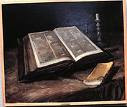
This is one the last works that Caravaggio ever painted. Circa: 1607.
The Head of John the Baptist is set upon a large plate by the alleged executioner. The ugly man appears neither pleased nor displeased with his work, and is merely following orders; though is aware of the prophet’s status amongst the Jews and the ‘reason’ for his execution.
Holding the plate though looking away in apparent shame is Salome, the daughter of Herodias.
Herodias, however, appears curious, somewhat pleased, whose image seems to merge with her daughter, Salome.
The head of John the Baptist is appalling, an expression of a man not exactly dead but in the midst of prayer…
According to the Gospel of Mathew in the New Testament, King Herod was having an affair with Herodias. Herodias is the wife of Herod’s brother, Phillip.
John the Baptist, the cousin of Jesus Christ, publicly announces the transgression of Herod and Herodias as against Jewish law. This public announcement causes John to be imprisoned. He wastes in prison and is tortured for many weeks while the followers of the prophet grow increasingly angry, crying for his release.
Something must be done...
It is Herod’s birthday and his entire court is in attendance. Herodias’ daughter, (who is not named in the Gospel of Mathew) on her mother’s request, dances for Herod, (the dance of the seven vales) and, as he is quite drunk, he promises with an “oath” that he will give Salome anything she desires. As this is a conspiracy planned by Herodias, her daughter requests the head of John the Baptist to be given to her in a “charger” (basket).
Herod winces but to not lose face with his court, orders that the execution be done...and the beheading follows only hours later.
In this particular scene, after the terrible deed is done, Salome takes the head to her mother with the help of the executioner and this is what we see in the painting.
This painting by Caravaggio lacks in his usual spectacular use of colour, almost, as some biographer’s have claimed, reflects the painter’s troubles at the time of the painting…and Caravaggio had a knack for getting himself into trouble.
Despite it lacklustre appearance and dismal content, the painting has always shocked my literal senses, somehow making this particular scripture ‘real’ and not simply a legend.
All would agree that this painting is another example of bringing his subjects and contexts to life - Caravaggio’s genius.
This piece is not one of my favourite works by the troubled Italian master, but certainly, when set against scripture, always fascinating.


No comments:
Post a Comment